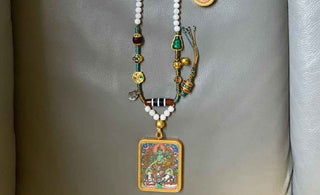
At the intersection of artistic brilliance and profound spirituality lies the captivating world of Thangka paintings, where each brushstroke is a sacred offering, and every hue carries the essence of enlightenment. The canvas becomes a sacred space, a realm where art and spirituality converge to create timeless masterpieces that have endured through the ages.
Thangka paintings, deeply rooted in Tibetan Buddhist tradition, go beyond mere artistic expression; they are portals to the divine, visual narratives that guide spiritual seekers on their journey. The intricate details and captivating colors found in these paintings are not arbitrary but carefully chosen elements that communicate with spiritual resonance. As observers engage with Thangkas, they embark on a visual pilgrimage, exploring a realm where art becomes a conduit for spiritual awakening.
One remarkable example of this convergence is found in the "18th Century White Tara Tibetan Antique Thangka Hand-painted With Mineral Color Materials Menbris Sama Style." In this Thangka, the captivating colors and intricate details stand as a testament to the artist's artistry and spiritual practice. The serene whites and blues delicately blend to portray White Tara, the compassionate goddess of longevity. The Menbris Sama style, known for its intricate detailing and vibrant color palette, becomes a distinctive mark of the artist's skill, adding a layer of spiritual significance to the painting.
The canvas of a Thangka is not merely a surface for artistic expression; it is a sacred ground where the artist engages in a contemplative and meditative practice throughout the creation process. Each brushstroke becomes a form of meditation, a deliberate act of mindfulness that goes beyond technical skill. The colors chosen carry symbolic significance deeply rooted in Buddhist iconography, creating a visual symphony that resonates with the core tenets of the philosophy.
As the eyes wander across the canvas, the intricate details of a Thangka captivate the observer. Every meticulous rendering, from the delicate features of deities to the celestial beings and ornate patterns adorning their attire, becomes a language that speaks to the viewer. The details are not mere embellishments but integral elements contributing to the spiritual narrative, inviting observers into a realm where every nuance is a sacred offering.
Thangka paintings play a dual role—they are aesthetic marvels that enhance the ambiance of living spaces, creating oases of tranquility, and they serve as ritualistic tools for individuals seeking solace and connection with the divine. In a bustling modern environment, a Thangka takes on a dual role. Its aesthetic allure enhances the ambiance of the living space, creating an oasis of tranquility amidst the urban clamor.
As an aesthetic marvel, the Thangka enhances the ambiance of living spaces, transforming them into sanctuaries of tranquility. The vibrant colors and intricate details of the Vajrapani Thangka become a visual hymn, infusing the surroundings with an aura of divine energy. The hand-painted precision, reflecting the skill and devotion of the artist, transforms the canvas into a portal to the sacred. Hung on the walls, the Thangka becomes a focal point, drawing the eye and inviting observers into a realm where beauty intertwines with the spiritual.
Simultaneously, the Thangka serves as a ritualistic tool, a conduit for individuals seeking solace and connection with the divine. In the meditative space, the observer engages with the Thangka as more than a visual masterpiece—it becomes a spiritual companion. The depiction of Vajrapani, the embodiment of spiritual power and protection, resonates with the viewer's inner quest for strength and solace. The Thangka, with its symbolism and sacred geometry, becomes a visual aid in meditation, guiding the mind towards transcendental states.
The "18th Century Vajrapani Tibetan Antique Thangka Purely Hand-painted" exemplifies the dual role of Thangkas with its impeccable craftsmanship and vibrant narrative. The Thangka becomes a silent mentor, offering solace to those in search of inner peace. Its presence transforms a space into a sanctuary where one can escape the cacophony of the world and find a moment of stillness and reflection.
Thangka paintings, with their dual identity, weave a narrative that transcends the realms of art and spirituality. It stands as a testament to the timeless dialogue between the aesthetic and the sacred, inviting individuals to embark on a journey where the mundane transforms into the extraordinary, and the ordinary becomes a vessel for the divine. In this delicate dance between the visual and the spiritual, Thangkas like Vajrapani continue to be beacons, illuminating the path for those seeking both beauty and transcendence in their lives.
The global appreciation for Thangka paintings contributes to cross-cultural understanding and dialogue. Exhibitions, educational programs, and collaborations with international artists create opportunities for people worldwide to connect with Tibetan heritage. The "Mahasthamaprapta Tibetan Thangka Pendant with the Eight Auspicious Tibetan Signs Shell" serves as a shining example, highlighting how Thangkas are not confined to traditional settings but have become symbols of a shared human experience.
Conclusion
In conclusion, Thangka paintings stand as profound examples of where art and spirituality converge. These visual narratives, crafted with devotion and precision, serve as bridges between the earthly and the divine. As observers engage with Thangkas, they partake in a sacred dialogue that transcends the limitations of language and culture, offering a universal experience of beauty, contemplation, and spiritual connection. Thangka paintings, with their captivating colors and intricate details, continue to illuminate the path where art and spirituality converge, inviting all who behold them to embark on a journey of inner awakening and transcendence.

18th Century Vajrapani Tibetan Antique Thangka Purely Hand-painted























